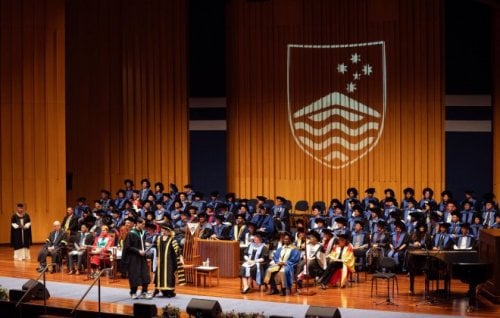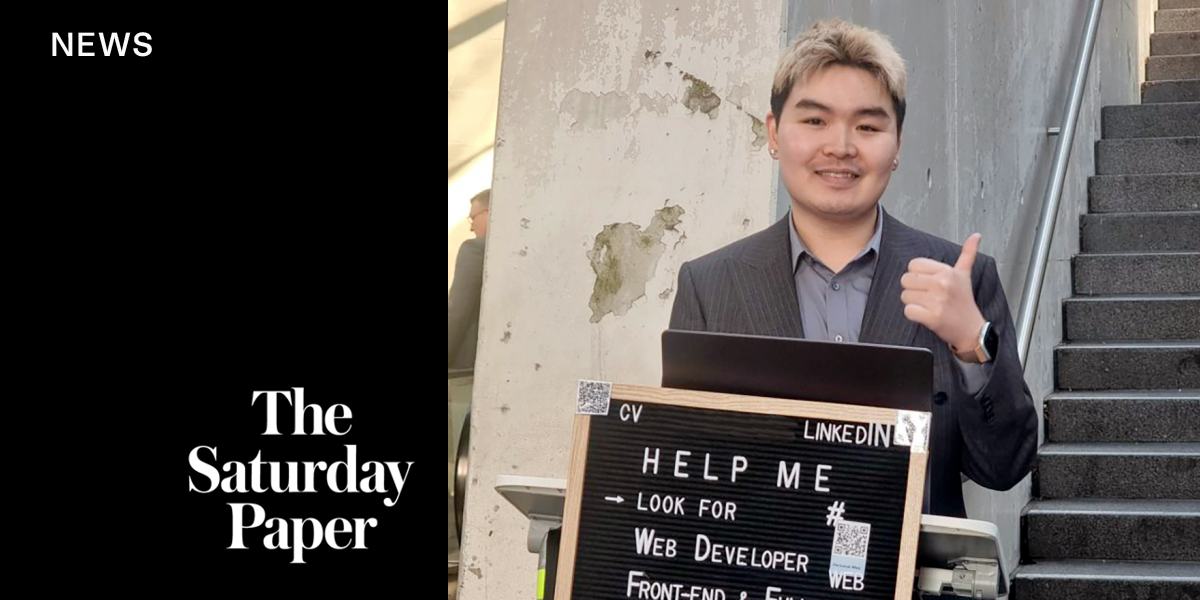Last year, Chinese international student Scott Cheung, armed with a master’s degree specialising in AI from UNSW Sydney, embarked on a year-long search and more than 300 fruitless applications for a job in the tech sector. At one point he resorted to holding a sign listing all his IT credentials on one of the busiest footbridges in Sydney’s CBD, desperately hoping a passer-by would stop and look at his résumé.
Now, having secured a position as a web developer in Queensland, he has proof of both the necessity of AI skills in IT and the difficulties Australian graduates experience finding work in an area the government has championed as this country’s future and the solution to decades of ailing productivity.
Cheung is far from alone in his turbulent jobseeking journey. Since early 2024, a growing number of Chinese international students – one of the largest cohorts of IT graduates in Australia – have been posting on social media about their struggles to start their careers here.
On the surface, this reflects two well-known trends in global labour markets. The first is that rising economic uncertainty has pushed corporations to save costs by investing more in AI-led automation and outsourcing contracts, leading to a decline in entry-level jobs and cuts to training. In its soon-to-be released annual “Digital Pulse” report, the Australian Computer Society (ACS) reveals only 1 per cent of IT employers rated Australian graduates as job ready, and 65 per cent reported having to reskill their new hires.
The problem was highlighted this week by Jobs and Skills Australia Commissioner Barney Glover, who told The Australian that research from his statutory body showed “too many engineering and IT graduates are not being hired for jobs they are technically qualified for, because they lack the employability skills that are required.”
“More needs to be done to link employers and universities together with TAFE to ensure that what is taught is both theoretically and practically relevant,” Glover said.
The shrinking job opportunities for young, inexperienced IT workers have concerned Marc Washbourne, co-founder of ReadyTech and board member of the government-funded Future Skills Organisation. “These roles are where people learn, grow and get started in their careers,” Washbourne says. “While there’s a lot of talk about how AI will change the way we work, there should be more concern for how it’s making it harder for new workers to get a foot in the door.
“AI doesn’t have to mean the death of the first job. But it does force us to rethink how we create, protect and evolve entry-level roles,” he says.
The second global trend is that due to increasing visa uncertainty and language barriers, employers tend to favour local graduates over their international counterparts. This isn’t quite true of Australia, where the tech sector has relied heavily on migrants like Cheung for decades. A report by the peak body representing the STEM workforce, Science & Technology Australia, in 2023 found 56 per cent of university-qualified STEM workers were born overseas.
“While there’s a lot of talk about how AI will change the way we work, there should be more concern for how it’s making it harder for new workers to get a foot in the door.”
Moreover, the demand from industry is strong. Last year, the ACS identified that an additional 52,000 tech workers are needed each year until the end of 2030 to fill roles.
According to the government-affiliated National Artificial Intelligence Centre (NAIC), a key problem for foreign students graduating from Australian universities with AI skills is a lack of pathways to employment. NAIC says Australia desperately needs better collaboration across the education, research, business and regulatory sectors to drive innovation.
According to an NAIC spokesperson, the centre’s latest report “reinforces that Australia’s tech workforce continues to rely heavily on skilled migration, particularly in advanced AI roles where domestic pipelines may not yet meet demand”.
“This highlights the need for more targeted pathways that integrate international graduates into the AI workforce,” the spokesperson says.
Importantly, the NAIC report noted that Australia still struggles to translate research into industry. This country contributes 1.88 per cent of global AI papers but acquires just 0.18 per cent of AI patents.
That failure to offer opportunities for top-flight graduates was highlighted by the case of Zizheng Pan, a Chinese international student who completed a master’s degree and PhD in computer science at the University of Adelaide and Monash University. Pan moved back to China in July 2024 after an internship with Nvidia in the United States and joined the founding team of DeepSeek – the AI that shocked the world early this year.
“This has been a traditional challenge in Australia, keeping great, innovative minds,” says John Munnelly, KPMG Australia’s chief digital officer.
Australia has had little trouble attracting them to study: seven of our universities appeared among Times Higher Education’s global top 100 universities for computer science for 2025.
Foreign students can pay up to $58,000 a year for an ICT undergraduate degree, and educators have taken various approaches to ensure those students are well trained to meet the demand. Academics point out, however, that the skill set employers most value is expanding, and goes beyond technical expertise.
Professor Peter Höfner at the Australian National University’s School of Computing says critical thinking skills are now much more in demand in the IT industry, as workers must make decisions about choosing AI tools that work best for companies.
Many AI-related roles also require strong communication skills to facilitate the rollout of AI in non-tech businesses. “This shift may disadvantage graduates who lack industry experience or broader professional networks,” the NAIC spokesperson says.
Adding to the competition for roles, Professor Paul Kennedy at the University of Technology Sydney says alumni have reported that many tech companies over the past two years have been laying off extra staff they hired during the pandemic and outsourcing more contracts offshore. “It just means that there’s more competition for the students that are coming out here.”
Betsy Gregg, director of operations at the ACS, notes that some companies in recent years have encouraged employees to reskill with micro-credentials, with good results. “It’s not just about producing more graduates, it’s about creating smarter mobility within the talent we already have,” she says.
Gregg, whose organisation is authorised by the Department of Home Affairs to conduct paid assessments of prospective skilled ICT migrants, says many tech-qualified migrants are also stuck in roles below their capability, without clear pathways to career progression.
“Australia lacks a nationally adopted, dynamic digital skills framework. Countries like Ireland and Finland have embedded such frameworks to guide education, migration and workforce policy in real time,” she says.
She also calls for more varied AI-related roles to be acknowledged in Australia’s skilled migration system. “Countries like the UAE, Canada and Germany have evolved their migration settings to attract AI product managers, interpreters and systems thinkers – roles critical to embedding emerging tech into industries like health, education and sustainability,” she says.
Gregg welcomes a move by the government to extend the 485 temporary graduate visas for outstanding IT graduates that came into effect in July last year. However, Trent Wiltshire, deputy director of the Grattan Institute’s economic prosperity program, says there are better ways to support international students to stay in Australia.
Previous Grattan Institute research has found that although 485 visas were originally introduced to allow international graduates more time to work in Australia and secure permanent pathways, they have left international students in visa limbo.
Wiltshire argues that employers should play a bigger role in the skilled migration system. “So that if employers need to find some skilled workers they’re struggling to find in Australia, they can get them from overseas and sponsor them to become either temporary or permanent migrants,” he says.
A Department of Home Affairs spokesperson says Australia’s skilled migration program “carefully targets migrants on the basis of their skills, attributes and suitability for employment so they are in a position to contribute quickly to the Australian economy”.
Asked by The Saturday Paper if the government has considered national demand for AI skills in its skilled migration programs for this financial year, the spokesperson says it “takes into consideration the economic conditions in Australia, future skill needs, changes in the labour market and the population objectives of states and territories”.
Besides visas, Wiltshire also called for the government to offer more support to help talented international graduates thrive when they are in Australia. “There are things like a campaign to help employers change their attitudes about employing people, on temporary graduate visas, or looking to sponsor workers.”
Cheung is just one month into his new role, but Australia’s AI ambitions mean he has to constantly upskill to ensure his job security. “I will still worry about the future,” he says, “but I also believe that the solution to adapt to technological revolution is to keep learning. Regardless of the changes in the future, I hope I can keep going and growing.”
This article was first published in the print edition of The Saturday Paper on
July 26, 2025 as “AI graduate glitches”.
For almost a decade, The Saturday Paper has published Australia’s leading writers and thinkers.
We have pursued stories that are ignored elsewhere, covering them with sensitivity and depth.
We have done this on refugee policy, on government integrity, on robo-debt, on aged care,
on climate change, on the pandemic.
All our journalism is fiercely independent. It relies on the support of readers.
By subscribing to The Saturday Paper, you are ensuring that we can continue to produce essential,
issue-defining coverage, to dig out stories that take time, to doggedly hold to account
politicians and the political class.
There are very few titles that have the freedom and the space to produce journalism like this.
In a country with a concentration of media ownership unlike anything else in the world,
it is vitally important. Your subscription helps make it possible.
Send this article to a friend for free.
Share this subscriber exclusive article with a friend or family member using share credits.
Used 1 of … credits
use share credits to share this article with friend or family.
You’ve shared all of your credits for this month. They will refresh on August 1. If you would like to share more, you can buy a gift subscription for a friend.
SHARE WITH A FRIEND
? CREDITS REMAIN
SHARE WITH A SUBSCRIBER
UNLIMITED
Loading…

News
Flaws in Australia’s skilled migration system
Wing Kuang
and Sherry Huang
The government’s attempts to prevent visa-hopping to favour skilled migrants have instead forced many highly qualified international students to retrain.


